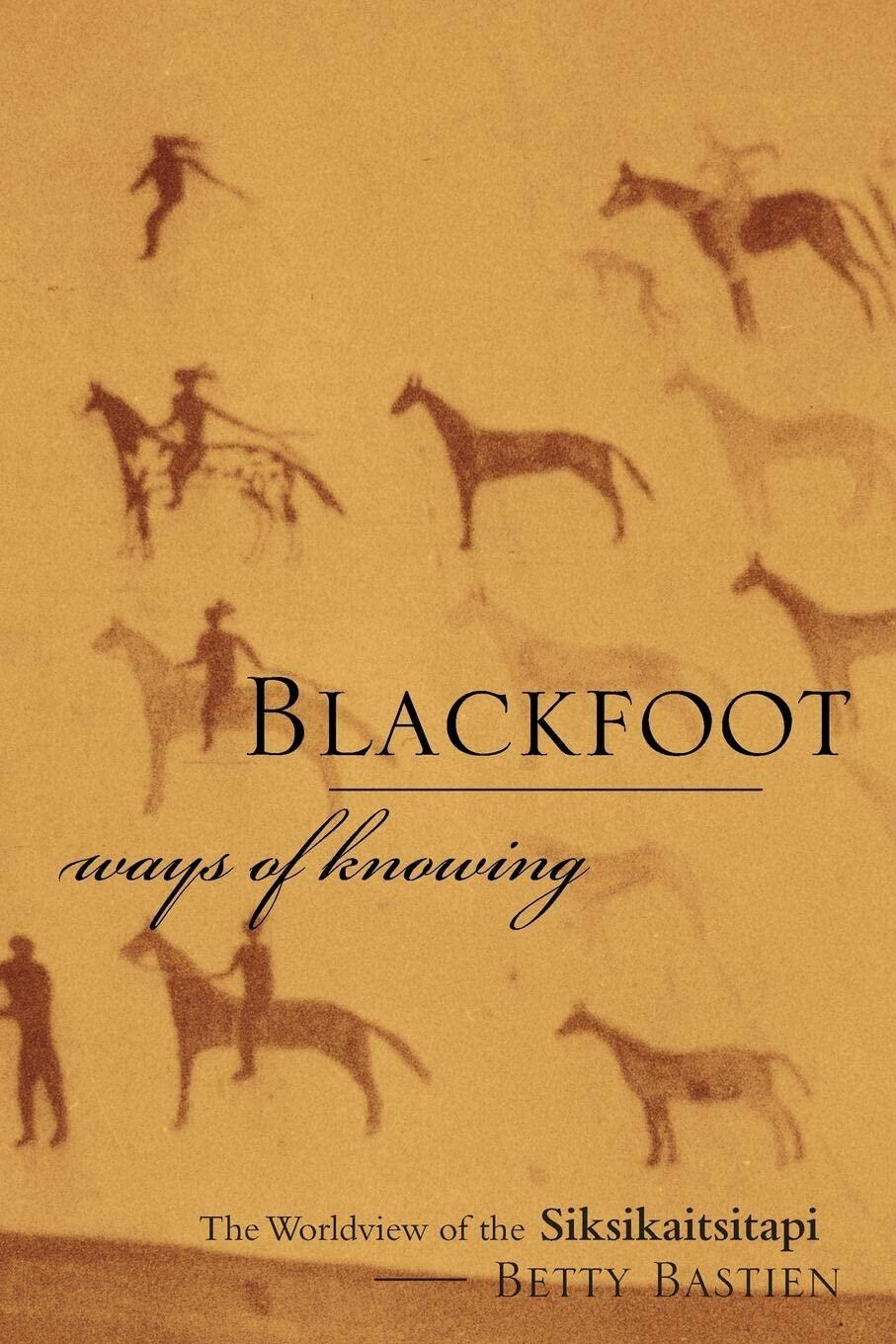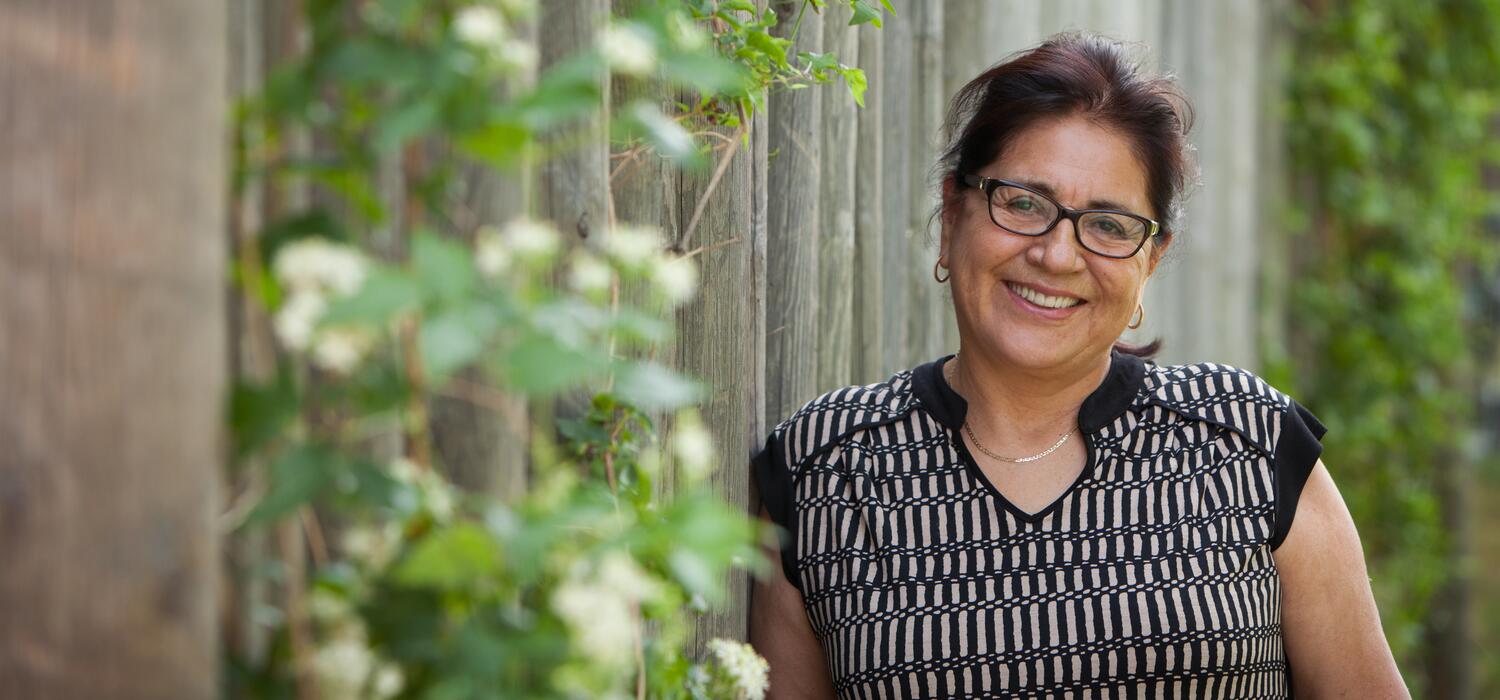
Dr. Bastien's landmark book Blackfoot Ways of Knowing: The Worldview of the Siksikaitsitapi is still used as a foundational text and is available online and in bookshops.
UCalgary press
June 5, 2023

Dr. Betty Bastien, PhD, recently passed away at her beloved home on the Piikani nation surrounded by her family. Bastien, who was part of the Faculty of Social Work for more than two decades as a student, teacher, researcher, and co-creator of the faculty’s community learning circle’s curriculum, was a trailblazer in the truest sense of the word. Her scholarship, work, determination, and passionate advocacy created a new way and in doing so, opened a path for others to follow.
As former social work dean Dr. Jackie Sieppert wrote in a letter supporting the University of Calgary Arch Award she received in 2017: “Dr. Bastien is recognized internationally for her leadership in strengthening Indigenous communities. Her vision and passion have helped create community-based healing approaches that restore Indigenous communities and provide a path toward reconciliation.”
While her passing is keenly felt by her family, friends, community, former colleagues and the social work profession, there is some comfort in reflecting on her amazing legacy. In advancing Indigenous ways of knowing in the academy, she created dialogue where there was little previously, and opened a pathway for generations of Indigenous social workers to come. In that way, her change was seismic, creating parallel pathways of accreditation and perhaps helping to bring more Indigenous social workers into the profession, helping to de-colonize the social work profession itself.
As a child, when Betty Bastien would leave her beautiful home on the Piikani nation, with its rippling grassland plains that roll up against the snow-capped foothills — she would view the settlers living in the surrounding towns, Pincher Creek, Lethbridge, Cardston perhaps — and she would wonder at the differences.
Why did they have so much stuff? So much of everything? Why did life seem so much easier for the settler children and their families?
“The differences were so stark,” she told me. “I didn't understand them.”
The desire to understand the yawning gulf propelled her forward into a life of action and purpose. A life that changed so much and created a better future for so many.
I had the rare opportunity and privilege to interview Betty Bastien several years back. I was new to the Faculty of Social Work, and I probably didn’t understand what a privilege it was at the time. It was an amazing time for Dr. Bastien. She was being recognized with a prestigious UCalgary Arch Award after formally retiring from the Faculty of Social Work. At the same time she was feverishly working to create a paradigm-shifting full curriculum at Red Crow College.
She told me that in some ways, she felt her life had come full circle. From learning Western knowledge and paradigms, to blending that knowledge with Blackfoot ways of knowing — to a new and better perspective.
“It's like all that knowledge I got from the West — in getting a PHD and all the education I received. Then working with Indigenous knowledge and that whole sense of blending that knowledge into the West. Now I get it all as Indigenous. Now I sit in that paradigm in terms of the Indigenous practice of social work.
“It has been a wonderful journey.”
Her journey initially began in sociology, where she attempted to better understand the gulf between Western and Indigenous Peoples. She said that degree helped create a structural understanding of Canada.
“I wanted to work in that area,” she said, “to be of service for Indigenous people. That's kind of what we're told as we're in our own upbringing, our own socialization, our communities — to support our nation.”
To that end, she knew she needed more education to do the things she wanted to do, so after graduating she accepted the University of Calgary’s offer and did her Bachelor of Social Work (BSW).
Like many, she says there was one professor and one course during her BSW that really changed her life: Dr. Jacqueline Ismael’s course in social policy.
“That course,” she said, “gave me a perspective of where and how to make a difference in terms of providing services that are relevant to the needs of the people who we were providing services to. Also, the whole notion of social justice — how to work in the social service area and to be an advocate for marginalized peoples. That course really gave me a sense of where I needed to go in my life — in my practice — and gave depth to what I can do.”
It was during her Master of Social Work — focused on social policy and service delivery — that she found the approach, in Ismael’s terms, the relevancy, for those she wanted to help. In studying how institutions work and how services are constructed for the marginalized, she began developing what she described as an Indigenous management paradigm.
“It was using our (Blackfoot) values to provide services that really are based on relational accountability,” she explained. “That really provided an opening of how I could start to practise from an Indigenous perspective.”
She began to “really go into depth” on the Blackfoot paradigm and struggled to find a way to teach this knowledge to her students. At the same time, she took on the heroic task of developing and bringing Indigenous knowledge systems into the academy.
“It starts with the heart,” she told me. “We called it Indigenous science. It's really that connection. I would say in a sense a spirituality, but people make it sound like its faith or something like that. It's really what we call the universal intelligence. There's a word — synchronicity — it's that holistic nature. That holistic, organic, relational nature of an Indigenous paradigm. And it starts with the heart.”
Her life brought her to a place where her heart could write the book that she knew needed to be written: Blackfoot Ways of Knowing: The Worldview of the Siksikaitsitapi.
Her book outlined how for the Blackfoot, knowledge is experiential, participatory, and ultimately sacred. She mapped out her own journey of coming to know, and how important the language we use is to our understanding of the world:
“You come from basic assumptions, which have been proven by quantum mechanics. It's an indivisible universe. Indivisible. We are interconnected, interdependent, reciprocal. It's a circle. Everything is in the moment and now. Our people knew this, I mean, we've been here 20,000 years. Colonization destroyed that, but this understanding was always there.”
“That is our way. That is how we understand the universe to work. When you think this way there are natural ethical principles and how to conduct ourselves. Our languages hold all that information.”
Language. Betty explained that the Blackfoot understood that we create our world, we create understanding, for better or worse, with the words we choose and the meanings we give them. They are literally the most powerful tool, and in colonization they are a weapon that inflicts one way of knowing the world while erasing another.
That’s why fighting for Indigenous language, culture and ceremony were so important to Betty along with notions of reciprocal responsibilities and interdependence. It’s also why she eventually left her position teaching in the Western system — even if the subject was Native American Studies.
“It doesn't nurture you as an academic or a person,” she said. “It was very cut and dry. It was always comparing Western and Indigenous paradigms, and it was comparisons made from a Western point of view — what some have called a systemic violence.”
It was about that time that salvation came from an unlikely source — the academy itself. Her former dean, Dr. Gayla Rogers, also a woman of vision, approached her with a unique proposition, to come back to teaching, but explicitly not from a Western lens. The faculty was pioneering an innovative distance-learning initiative that set out to embrace Indigenous ways of knowing, and Gayla knew that Betty was just the woman for the job.
Betty agreed, on the condition she be allowed to work from home, and then set about putting the principles she had developed into action. Even years later Bastien spoke with emotion recalling that period in her life.
“I just get blown away now when I look at what they had given me!” she said. “I really want to acknowledge how the University of Calgary created a space for me to practise my Indigenous knowledge and how we connect it to the ceremonies and to the land. Those are all the essential parts. Colonization destroyed all those parts, and those were the essential parts the University of Calgary gave me so that I could work.”
And work she did. The position seemed to engage everything that she carried within her, including her PhD in integral studies where she had begun to develop the bones of what an Indigenized curriculum might look like. She threw herself into helping build the Learning Circles curriculum and said she loved it, “deepening and immersing” herself in knowledge to be able to teach it.
She worked for the better part of two decades, once again blazing a trail that made it possible for other schools to follow, while simultaneously creating a curriculum that resonated with generations of social workers in rural and remote communities across Alberta. But the scope of her work, like her impact, was vast. Besides being an educator, she was also a researcher, she also worked inside social service and child welfare systems, and she spoke out frequently — a fierce advocate who brought awareness and change.
In describing her legacy, her husband, Henry Big Throat said simply, “She became an institution. She led the creation of the Indigenous BSW and an Indigenous MSW which was recognized and accredited by the Canadian Association for Social Work Education and accredited by the National Indigenous Accreditation Board.”

Dr. Bastien's landmark book Blackfoot Ways of Knowing: The Worldview of the Siksikaitsitapi is still used as a foundational text and is available online and in bookshops.
UCalgary press
At the time, journalist Mary Weasel Fat described the accreditation agreement itself as an act of sovereignty that knocked open a door between Western and Indigenous worlds, creating “a parallel accreditation process with Alberta Education … founded on the assertion of Indigenous knowledge systems designed to explore solutions to contemporary issues from an Indigenous Blackfoot perspective and interpretation.”
In her so-called “retirement” she continued to speak out, advocate and generally shake things up.
“In the last conversation I had with Betty, last year, she encouraged us to bring in Elders and have conversations and Circles in our faculty and in community about how to decolonize social work together,” recalls current Dean of Social Work Ellen Perrault.
“She also encouraged us to teach and model social work in a way that honours Indigenous ways of knowing. I hope we can keep Betty’s legacy alive through our work and day-to-day commitments. Working together and serving in ways that are rooted in Indigenous ways of knowing.”
Working toward those goals would, of course, be the best way to remember her and, perhaps, to blaze a new path and start a new circle ourselves.
UCalgary Social Work is Canada’s innovative school of social work. Our commitment to decolonizing our faculty and the profession includes our support of Kiipitakyoyis (Grandmothers' Lodge) within the Faculty of Social Work. We are the largest school of social work in Canada, and a perennial research leader. Social workers are needed everywhere, in fact social work is Alberta’s most in-demand profession. If you’re looking for a meaningful career, check our our full range of fully online and blended (mix of on-campus and in-person) programs.